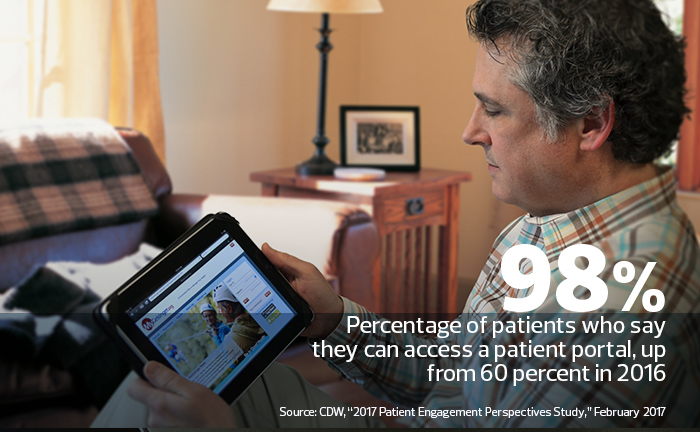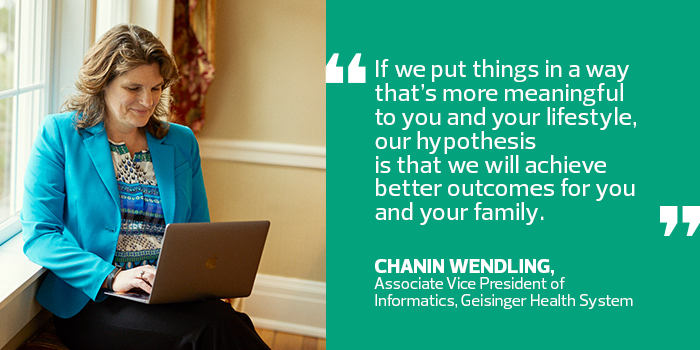Mobile Tools, Innovative Programs Bolster Patient Engagement for Providers
For Geisinger Health System, based in the central Pennsylvania town of Danville, launching a patient portal was just the start of its effort to engage its patients and help them better manage their healthcare through the increased use of technology.
The portal, which remains hugely popular since its 2001 rollout, serves as a foundation for many of the health system’s continued efforts to bring patients close to their care. Today, that work features the use of mobile devices and innovative apps.
“What we want to do with technology is enable patients to better manage a condition, have a better quality of life, and stay out of the emergency department or hospital,” says Chanin Wendling, Geisinger’s associate vice president of informatics and director of Geisinger in Motion, a division within informatics charged specifically with boosting patient engagement through mobile and internet technology. Led by Wendling, Geisinger in Motion most recently has rolled out mobile apps for prescription refills and surgery preparation; produced interactive e-books to educate people about their conditions; and started using text messages for appointment reminders and advice about managing weight and diabetes.
Geisinger is hardly alone in turning to technology to more closely connect with its patient population. Healthcare providers nationwide increasingly are prioritizing patient engagement as they seek to operate more efficiently, improve population health and satisfaction, and lower medical costs.
Providers Embrace Tools to Up Patient Engagement
More than 70 percent of healthcare providers say improving patient engagement is a top priority, up from 60 percent in 2016, according to CDW’s "2017 Patient Engagement Perspectives Study." In addition, 70 percent of patients say they have become more engaged with their healthcare during the past two years, up from 57 percent in 2016.
 By using technology to inform and interact with patients, providers can help individuals make better health decisions and improve their outcomes, says Lynne Dunbrack, research vice president for IDC Health Insights.
By using technology to inform and interact with patients, providers can help individuals make better health decisions and improve their outcomes, says Lynne Dunbrack, research vice president for IDC Health Insights.
“Effective patient engagement also includes behavioral coaching to help consumers make the necessary lifestyle changes to pursue their healthcare objectives,” Dunbrack says. “Better patient adherence to care plans results in less need for clinical intervention.”
Pushing Proactive Care with Wireless Tech
Adherence is the name of the game for Ochsner Health System, which boasts 29 hospitals and 60 health centers in Louisiana. The New Orleans-based system’s digital medicine program, for instance, allows hypertension patients to wirelessly upload remote blood pressure readings to an app on their smartphone; the readings are also recorded in their electronic health records.
Pharmacists and health coaches monitor the results and contact patients if they need to adjust medication or suggest lifestyle changes to them, says Dr. Richard Milani, chief clinical transformation officer at Ochsner.
Custom software on the back end analyzes the blood pressure data in real time, prioritizing patients in order of importance. Therefore, pharmacists and health coaches know which patients to contact first if their blood pressure readings are too high or too low.
“We don’t handle everyone’s blood pressure the same way,” Milani says. “If a user’s blood pressure is a little high or even super high, we’ve built a variety of decision trees based around the data.”
As part of the program’s initial pilot in 2015, Ochsner also equipped patients with an Apple Watch, providing medication and exercise reminders, activity tracking and prescription renewal notifications.
The program is making a huge impact: 73 percent of participants who started with high blood pressure had it under control within 90 days, Milani says.
 “Patients like the convenience factor,” he says. “They don’t have to come to the office to have interventions done.”
“Patients like the convenience factor,” he says. “They don’t have to come to the office to have interventions done.”
The same goes for Geisinger’s text messaging program, which patients enroll in via the portal. It’s allowing the healthcare system to remotely stay in touch with users and provide motivation on managing their weight or diabetes.
Overweight patients may visit a physician and get a weight loss plan, but could easily get discouraged between their first visit and a follow-up appointment months later.
By signing up for text messages, they receive tips, reminders and words of encouragement three times per week over a 12-week period, Wendling says. Clinicians create the content. The program runs on a Geisinger-developed custom application that integrates with a third-party vendor, which in turn, delivers the text messages to patients.
“It helps the clinical team help patients achieve their goal of losing weight,” she says.
Tablets Connect Patients to In-Hospital Innovation
Inside its facilities, Geisinger uses tablets to interact with admitted patients. In 2015, it began equipping hospital patients with iPad devices, so they could review their health records and also entertain themselves. So far, the health system has deployed 250 iPads in three of its hospitals.
Patients can access 100-plus apps, including a patient bedside app that provides educational resources, information about their care team and what to expect during their stay. They can also connect to their Apple ID accounts to access their own movies and music.
“We get consistent feedback that having an iPad is a diversion and helps patients reduce their pain, discomfort and stress,” Wendling says. “If we put things in a way that’s more meaningful to you and your lifestyle, our hypothesis is that we will achieve better outcomes for you and your family.”
Meanwhile, Ochsner built Apple Store-like patient counters (complete with barstool seating) in four of its largest health centers. Instead of selling and troubleshooting Apple products, the health system’s “O Bar” features a counter full of iPads, where patients can check out physician-recommended health and wellness apps.
Patients can also purchase wireless blood pressure monitors, wireless scales, and Bluetooth-enabled blood glucose monitors/activity trackers for home monitoring. A tech specialist provides guidance on choosing apps as well as training on using the wireless technology.
“It’s a free service, and it’s been remarkably successful as a patient engagement tool,” Milani says.
Reducing Wait Times with Smartphone Apps
Mobile apps are also helping to improve convenience and increase patient engagement and satisfaction for Woodbury, N.J.–based Inspira Health Network, says Tom Pacek, vice president and CIO. The health system’s main MyInspira app provides a one-stop shop where customers can check emergency room wait times, pay bills, sign into the patient portal, text chat with a health adviser or call a concierge for assistance.
In 2016, the health network launched a second app, Inspira Access, which lets patients locate the closest urgent care centers and the wait times at each one.
In January, the health system added a new feature that lets users check in and get on the waiting list before they arrive, which reduces wait time, Pacek says.
“You can get on our schedule to let us know you are coming,” he says. “It’s like calling ahead to a restaurant to put your name on the list, so when you get there, you’re the next one in line.”
Future plans for the mobile apps include making the check-in feature available for imaging and lab appointments, and creating a “health wallet” so patients can fill out registration forms before their appointments.
“It’s about engaging patients and making it easy for them to come to us and use our services,” Pacek says.









